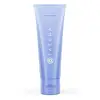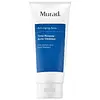What's inside
What's inside
 Key Ingredients
Key Ingredients

 Benefits
Benefits

 Concerns
Concerns

 Ingredients Side-by-side
Ingredients Side-by-side

Water
Skin ConditioningMicrocrystalline Cellulose
AbsorbentPropanediol
SolventSodium Cocoyl Glutamate
CleansingGlycerin
HumectantAcrylates Copolymer
Sodium Caproyl Methyltaurate
CleansingCoco-Betaine
CleansingParfum
MaskingCamellia Sinensis Leaf
PerfumingOryza Sativa Powder
Chondrus Crispus Extract
Skin ConditioningSodium Hyaluronate
HumectantBetaphycus Gelatinum Extract
BleachingLauryl Glucoside
CleansingPotassium Hydroxide
BufferingPolyquaternium-39
Disodium EDTA
Phenoxyethanol
PreservativeEthylhexylglycerin
Skin ConditioningSodium Benzoate
MaskingSodium Carbonate
BufferingAlcohol
AntimicrobialWater, Microcrystalline Cellulose, Propanediol, Sodium Cocoyl Glutamate, Glycerin, Acrylates Copolymer, Sodium Caproyl Methyltaurate, Coco-Betaine, Parfum, Camellia Sinensis Leaf, Oryza Sativa Powder, Chondrus Crispus Extract, Sodium Hyaluronate, Betaphycus Gelatinum Extract, Lauryl Glucoside, Potassium Hydroxide, Polyquaternium-39, Disodium EDTA, Phenoxyethanol, Ethylhexylglycerin, Sodium Benzoate, Sodium Carbonate, Alcohol
Water
Skin ConditioningDisodium Cocoamphodiacetate
CleansingGlycerin
HumectantCetyl Alcohol
EmollientCocamidopropyl Betaine
CleansingCetearyl Alcohol
EmollientSodium Cocoyl Isethionate
CleansingPEG-100 Stearate
Glyceryl Stearate
EmollientButylene Glycol
HumectantSodium Hyaluronate
HumectantTocopheryl Acetate
AntioxidantCaprylic/Capric Triglyceride
MaskingRetinol
Skin ConditioningSalix Alba Bark Extract
AstringentAscorbic Acid
AntioxidantChitosan
Silver Citrate
AntimicrobialSodium PCA
HumectantBetaine
HumectantSorbitol
HumectantGlycine
BufferingAlanine
MaskingProline
Skin ConditioningSerine
MaskingThreonine
Arginine
MaskingLysine
Skin ConditioningGlutamic Acid
HumectantZinc Gluconate
Skin ConditioningArgania Spinosa Kernel Extract
Skin ConditioningSerenoa Serrulata Fruit Extract
Skin ConditioningSesamum Indicum Seed Extract
Skin ConditioningCimicifuga Racemosa Root Extract
AntimicrobialMelaleuca Alternifolia Leaf Oil
AntioxidantCocamidopropyl Dimethylamine
EmulsifyingZea Mays Starch
AbsorbentHydrolyzed Corn Starch
HumectantHydrolyzed Corn Starch Octenylsuccinate
AbsorbentCitric Acid
BufferingDisodium EDTA
Propyl Gallate
AntioxidantPolysorbate 80
EmulsifyingMenthol
MaskingCetearyl Glucoside
EmulsifyingGlycol Distearate
EmollientSteareth-4
EmulsifyingPEG-150 Distearate
EmulsifyingHydroxyethylcellulose
Emulsion StabilisingPolyacrylate-13
Polyisobutene
Polysorbate 20
EmulsifyingTrisodium Ethylenediamine Disuccinate
Phenoxyethanol
PreservativeCaprylyl Glycol
EmollientChlorphenesin
AntimicrobialParfum
MaskingWater, Disodium Cocoamphodiacetate, Glycerin, Cetyl Alcohol, Cocamidopropyl Betaine, Cetearyl Alcohol, Sodium Cocoyl Isethionate, PEG-100 Stearate, Glyceryl Stearate, Butylene Glycol, Sodium Hyaluronate, Tocopheryl Acetate, Caprylic/Capric Triglyceride, Retinol, Salix Alba Bark Extract, Ascorbic Acid, Chitosan, Silver Citrate, Sodium PCA, Betaine, Sorbitol, Glycine, Alanine, Proline, Serine, Threonine, Arginine, Lysine, Glutamic Acid, Zinc Gluconate, Argania Spinosa Kernel Extract, Serenoa Serrulata Fruit Extract, Sesamum Indicum Seed Extract, Cimicifuga Racemosa Root Extract, Melaleuca Alternifolia Leaf Oil, Cocamidopropyl Dimethylamine, Zea Mays Starch, Hydrolyzed Corn Starch, Hydrolyzed Corn Starch Octenylsuccinate, Citric Acid, Disodium EDTA, Propyl Gallate, Polysorbate 80, Menthol, Cetearyl Glucoside, Glycol Distearate, Steareth-4, PEG-150 Distearate, Hydroxyethylcellulose, Polyacrylate-13, Polyisobutene, Polysorbate 20, Trisodium Ethylenediamine Disuccinate, Phenoxyethanol, Caprylyl Glycol, Chlorphenesin, Parfum
 Reviews
Reviews

Ingredients Explained
These ingredients are found in both products.
Ingredients higher up in an ingredient list are typically present in a larger amount.
Disodium EDTA plays a role in making products more stable by aiding other preservatives.
It is a chelating agent, meaning it neutralizes metal ions that may be found in a product.
Disodium EDTA is a salt of edetic acid and is found to be safe in cosmetic ingredients.
Learn more about Disodium EDTAGlycerin is already naturally found in your skin. It helps moisturize and protect your skin.
A study from 2016 found glycerin to be more effective as a humectant than AHAs and hyaluronic acid.
As a humectant, it helps the skin stay hydrated by pulling moisture to your skin. The low molecular weight of glycerin allows it to pull moisture into the deeper layers of your skin.
Hydrated skin improves your skin barrier; Your skin barrier helps protect against irritants and bacteria.
Glycerin has also been found to have antimicrobial and antiviral properties. Due to these properties, glycerin is often used in wound and burn treatments.
In cosmetics, glycerin is usually derived from plants such as soybean or palm. However, it can also be sourced from animals, such as tallow or animal fat.
This ingredient is organic, colorless, odorless, and non-toxic.
Glycerin is the name for this ingredient in American English. British English uses Glycerol/Glycerine.
Learn more about GlycerinParfum is a catch-all term for an ingredient or more that is used to give a scent to products.
Also called "fragrance", this ingredient can be a blend of hundreds of chemicals or plant oils. This means every product with "fragrance" or "parfum" in the ingredients list is a different mixture.
For instance, Habanolide is a proprietary trade name for a specific aroma chemical. When used as a fragrance ingredient in cosmetics, most aroma chemicals fall under the broad labeling category of “FRAGRANCE” or “PARFUM” according to EU and US regulations.
The term 'parfum' or 'fragrance' is not regulated in many countries. In many cases, it is up to the brand to define this term.
For instance, many brands choose to label themselves as "fragrance-free" because they are not using synthetic fragrances. However, their products may still contain ingredients such as essential oils that are considered a fragrance by INCI standards.
One example is Calendula flower extract. Calendula is an essential oil that still imparts a scent or 'fragrance'.
Depending on the blend, the ingredients in the mixture can cause allergies and sensitivities on the skin. Some ingredients that are known EU allergens include linalool and citronellol.
Parfum can also be used to mask or cover an unpleasant scent.
The bottom line is: not all fragrances/parfum/ingredients are created equally. If you are worried about fragrances, we recommend taking a closer look at an ingredient. And of course, we always recommend speaking with a professional.
Learn more about ParfumPhenoxyethanol is a preservative that has germicide, antimicrobial, and aromatic properties. Studies show that phenoxyethanol can prevent microbial growth. By itself, it has a scent that is similar to that of a rose.
It's often used in formulations along with Caprylyl Glycol to preserve the shelf life of products.
Sodium Hyaluronate is hyaluronic acid's salt form. It is commonly derived from the sodium salt of hyaluronic acid.
Like hyaluronic acid, it is great at holding water and acts as a humectant. This makes it a great skin hydrating ingredient.
Sodium Hyaluronate is naturally occurring in our bodies and is mostly found in eye fluid and joints.
These are some other common types of Hyaluronic Acid:
Learn more about Sodium HyaluronateWater. It's the most common cosmetic ingredient of all. You'll usually see it at the top of ingredient lists, meaning that it makes up the largest part of the product.
So why is it so popular? Water most often acts as a solvent - this means that it helps dissolve other ingredients into the formulation.
You'll also recognize water as that liquid we all need to stay alive. If you see this, drink a glass of water. Stay hydrated!
Learn more about Water